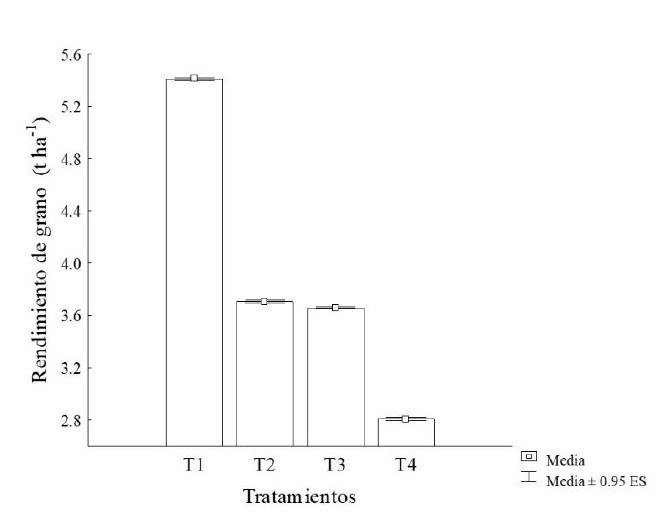Biostimulant application increases yield components of Bill Z Pinto beans in southern Sonora
DOI:
https://doi.org/10.29312/remexca.v13i2.2846Keywords:
Phaseolus vulgaris L., foliar nutrition, pods per plantAbstract
Taking into consideration the importance of beans for human nutrition, and the contribution of local production to the regional food security in the south of the state of Sonora, a trial was established during the spring-summer 2020 cultivation cycle in the Block 2110 of the Yaqui Valley. The experiment aimed to evaluate the effect of the application of three commercial biostimulants in the yield components of bean, variety Pinto Bill Z. Four treatments with four repetitions were established: T1 (FloraStart®); T2 (Austar®); T3 (mixture of Tricel-20® + Aminocel 500®, 1:1 ratio) and T4 (control, without biostimulant application) in a completely randomized experimental design. The treatments were applied only once during the flowering phenophase R6. The variables evaluated were number of pods per plant, pod length, number of grains per pod, grain mass per pod and per plant, and grain yield. The use of biostimulants increased the number of pods per plant in the evaluated variety. The pod length and the number of grains per pod did not show significant variation with respect to control. The T1 was the one that most contributed to the increase in the number of pods per plant, to the individual grain mass and, consequently, to the grain yield (5.4 t ha-1), with an increase of 2.3 t ha-1 with respect to the control, which demonstrates the feasibility of their application to increase the production of Bill Z Pinto beans in southern Sonora.
Downloads
References
Acosta-Gallegos, J. A.; Jiménez-Hernández, Y.; Anaya-López, J. L. y Padilla-Valenzuela, I. 2018. Producción de frijol de tipo Azufrado-Peruano bajo riego en Guanajuato. Celaya, Guanajuato, México. Folleto Técnico Núm. 8. ISBN: 978-607-37-0980-4. 28 p. https://www.vun.inifap.gob.mx.
Arellano, A. S.; Osuna, E. S.; Martínez, C. M. A. y Reyes, M. 2015. Rendimiento de frijol fertilizado con estiércol bovino en condiciones de secano. Rev. Fitotec. Mex. 38(3):313-318. http://www.scielo.org.mx/scielo.php?script=sci-arttext&pid=S018773802015000300 010&lng=es&nrm=iso.
Boote, K. J.; Prasad, V.; Allen Jr, L. H.; Singh, P. and Jones, J. W. 2018. Modeling sensitivity of grain yield to elevated temperature in the DSSAT crop models for peanut, soybean, dry bean, chickpea, sorghum, and millet. Eur. J. Agron. 100(10):99-109.. Doi: https://doi.org/10.1016/j.eja.2017.09.002.
CEDRSSA. 2020. Centro de Estudios para el Desarrollo Rural Sustentable y la Soberanía Alimentaria. Mercado de frijol, situación y perspectiva. http://www.cedrssa.gob.mx/files/b/ 13/53Mercado%20del%20frijol.pdf.
Dapaah, H. K.; Mckenzie, B. A. and Hill, G. D. 2010. Effects of irrigation and sowing date on phenology and yield of pinto beans (Phaseolus vulgaris, L.) in Canterbury, New Zealand. J. Crop Hortic. Sci. 27(4): 297-305. Doi: https://doi.org/10.1080/01140671.1999.9514109.
Fisher, R. A. 1937. The design of experiments. Edinburgh, London. 260 p.
Kolmogorov, A. T. 1933. Basic Concepts of Probability Theory. Berlín, Julius Springer. 62 p.
López-Salinas, E.; Tosquy-Valle, O. H.; Villar-Sánchez, B.; Acosta-Gallegos, J. A.; Rodríguez-Rodríguez, J. R. y Andrés-Meza, P. 2015. Rendimiento y estabilidad de líneas mejoradas de frijol negro en Veracruz y Chiapas, México. Rev. Fitotec. Mex. 38(2):173-181.
Montecillo-Cedillo, J. L. 2017. Rendimiento por hectárea de sorgo grano y de fríjol en México: riego vs temporal. Economía Informa. 403:91-101. Doi: https://doi.org/10.1016/ j.ecin.2017.05.006.
Padilla, V. I.; Castillo, T. N.; Ramírez, A. J. A.; Armenta, C. I.; Cabrera, C. F.; Madrid, C. M. y Ortiz, E. J. E. 2009. Manual para la producción de frijol en el Sur de Sonora. Campo Experimental Valle del Yaqui-CIRNO-INIFAP. Folleto técnico núm. 69.
Prieto-Cornejo, M. R.; Matus-Gardea, J. A.; Gavi-Reyes, F.; Omaña-Silvestre, J. M.; Brambila-Paz, J. J.; Sánchez-Escudero, J. y Martínez-Damián, M. Á. 2019. Evolución de la superficie cultivada de frijol e impacto económico de la sequía sobre su rendimiento bajo condiciones de temporal en México. Rev. Fitotec. Mex. 42(2):173-182. http://www.scielo.org.mx/ scielo.php?script=sci-arttext&pid=S018773802019000200173 &lng=es&nrm=iso.
Romero-Félix, C. S.; López-Castañeda, C.; Kohashi-Shibata, J.; Miranda-Colín, S.; Aguilar-Rincón, V. H. y Martínez-Rueda, C. G. 2019. Cambios en el rendimiento y sus componentes en frijol bajo riego y sequía. Rev. Mex. Cienc. Agríc. 10(2):351-364. Doi: https://doi.org/10.29312/remexca.v10i2.1607.
SIAP. 2021. Sistema de Información Agroalimentaria y Pesquera. Avance de siembras y cosechas, resumen por estado. http://infosiap.siap.gob.mx:8080/agricola-siap-gobmx/Resumen Producto.do.
Tukey, J. W. 1960. A survey of sampling from contaminated distributions. In: Olkin, I. (Ed.). Contribution to probability and statistics: essays in honor to harold hotelling. Redwood City. Stanford University Press. 448-485 pp.

Published
How to Cite
Issue
Section
License
Copyright (c) 2022 Revista Mexicana de Ciencias Agrícolas

This work is licensed under a Creative Commons Attribution-NonCommercial 4.0 International License.
The authors who publish in Revista Mexicana de Ciencias Agrícolas accept the following conditions:
In accordance with copyright laws, Revista Mexicana de Ciencias Agrícolas recognizes and respects the authors’ moral right and ownership of property rights which will be transferred to the journal for dissemination in open access. Invariably, all the authors have to sign a letter of transfer of property rights and of originality of the article to Instituto Nacional de Investigaciones Forestales, Agrícolas y Pecuarias (INIFAP) [National Institute of Forestry, Agricultural and Livestock Research]. The author(s) must pay a fee for the reception of articles before proceeding to editorial review.
All the texts published by Revista Mexicana de Ciencias Agrícolas —with no exception— are distributed under a Creative Commons License Attribution-NonCommercial 4.0 International (CC BY-NC 4.0), which allows third parties to use the publication as long as the work’s authorship and its first publication in this journal are mentioned.
The author(s) can enter into independent and additional contractual agreements for the nonexclusive distribution of the version of the article published in Revista Mexicana de Ciencias Agrícolas (for example include it into an institutional repository or publish it in a book) as long as it is clearly and explicitly indicated that the work was published for the first time in Revista Mexicana de Ciencias Agrícolas.
For all the above, the authors shall send the Letter-transfer of Property Rights for the first publication duly filled in and signed by the author(s). This form must be sent as a PDF file to: revista_atm@yahoo.com.mx; cienciasagricola@inifap.gob.mx; remexca2017@gmail.
This work is licensed under a Creative Commons Attribution-Noncommercial 4.0 International license.


